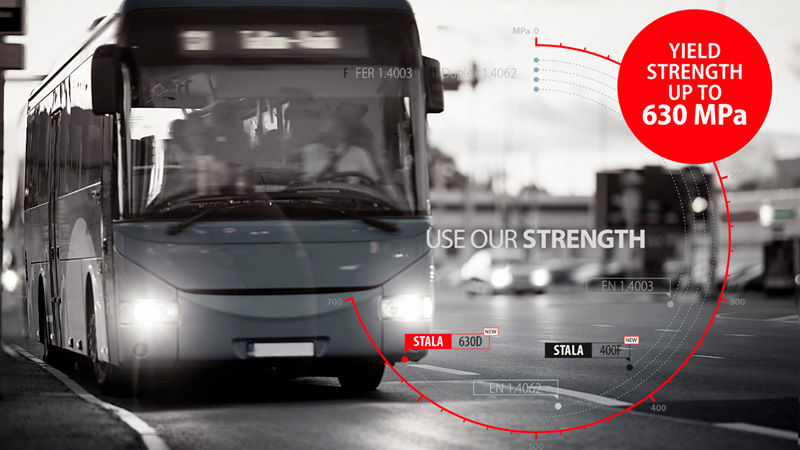Modern bus builders are growingly interested in using high-strength lean duplex as part of their bus body designs. Lean duplex is increasingly used in the tubes and tube components that make up a bus or coach body. A cost-effective, light-weight body can be manufactured by combining lean duplex parts and ferritic parts; both materials allowing for dissimilar welds.
Stalatube has a long experience in supplying bus body builders with high-strength lean duplex EN 1.4062 and EN 1.4162 tubes and tube components alongside those made of ferritic EN 1.4003. We work closely with bus and coach building companies across the globe to determine the best optimization scheme that will realistically allow for a 150 to 500-kilogram weight-save in a bus or coach body.
The weight-save in turn cuts the operator’s payback time to sometimes just months; this is achieved through decreased fuel consumption and fuel costs as well as increased passenger capacity. A mere 150-kilogram weight-save will also lessen CO2 emissions – according to our calculations by about 1 200 kilograms per bus per year. The number grows when aiming for an even greater weight-save.
STALA 630D for further enhanced strength
While modern lean duplex grades EN 1.4062 (DX 2202) and EN 1.4162 (LDX 2101) with their nominal yield strength of 500 MPa are already considered high-strength as is, we have brought to the market strength class Stala 630D for further increased yield strength up to 630 MPa. Stala 630D is available for EN 1.4062 and EN 1.4162, which are two of the most common lean duplex grades used in our tubes and tube components for the transportation industry.
To provide more specific data on the properties of our tubes and components made with strength class Stala 630D, we tested their yield strength, tensile strength, and elongation to break. As several tube sizes were tested, we were also able to obtain interesting information as to which tube sizes performed best in these aspects.
Naturally, there are several other factors to consider in bus body design as well. We have previously shared a study about different tube sizes’ energy absorption and moment resistance capacities, comparing three materials: lean duplex EN 1.4062, ferritic EN 1.4003 and mild steel S355. In these bending tests, lean duplex performed best in terms of both energy absorption and moment resistance. To read more, download full report on our website here.
Strength and elongation properties of STALA 630D tubes
We tested the strength and elongation properties of square and rectangular tubes of several sizes, ranging from 40×40 mm to 100×60 mm. Thicknesses were between 1.5 mm and 4 mm. All tubes were made of lean duplex EN 1.4062 with Stala 630D strength class.
The test results tell us that lean duplex tubes with Stala 630D have a good energy absorption capacity.
The test showed that the yield strength of lean duplex square and rectangular tubes is high, and elongation to break is very good considering the also high tensile strength. The yield strength of all samples was between 650-785 MPa, tensile strength between 880-990 MPa and elongation to break from 12 to 27.3 % (A50). No extensive variance was found between the different tube sizes, but good examples in the bunch were 50x50x2.5 mm and 40x40x1.5 mm. Both reached yield strength slightly above 690 MPa and elongation to break above 23 %. The tensile strength (Rm) was 944 MPa in the former and 987 MPa in the latter.
The test results tell us that lean duplex tubes with Stala 630D have a good energy absorption capacity; the greater the elongation at break, the more energy is stored in the tube. In the transportation industry and in building bus and coach frames, this is rather meaningful: it tells us about how well structures made of these products will behave and controllably collapse in case of an accident.
Smart optimization for maximal benefits
As a company, we are a big believer in doing things in a smart, efficient way. We are constantly working with customers to find the best solutions for their bus bodies. Combining ferritic EN 1.4003 tubes and tube components with lean duplex counterparts further fortified with Stala 630D can be done in multiple ways, depending on the individual bus body designs.
Read a recent reference story of our long-standing customer, who has made the shift to lean duplex optimized models.
If you are interested in learning more about this topic, you can register for one of our free-of-charge live webinars or request for a private webinar / Q&A session for your own company.
